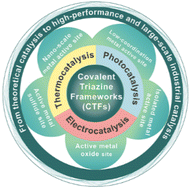Metallic active-site engineering: a bridge between covalent triazine frameworks and high-performance catalysts
Abstract
Covalent triazine frameworks (CTFs) with structure designability and multifunctionalities have aroused increasing attention in conventional thermocatalysis and modern photocatalysis/electrocatalysis. However, many obstacles still exist on the road to simultaneously achieving high activity, selectivity, and operation durability when employing sole CTFs in specific catalytic applications. Among numerous modification approaches of CTFs, engineering metallic active sites (low-coordination/nano-scale/isolated metal active sites active metal oxide/sulfide sites) into as-prepared CTFs has been confirmed to be an effective strategy. In this review, state-of-the-art research and evolution history over metallic active-site engineering of CTFs in catalysis are summarized and analyzed from the perspectives of structure–function correlations. Eventually, the present technical limitations of metallic active-site engineering of CTFs and future development in practical catalytic applications are presented. This review may inspire the forthcoming exploration and in-depth perceptions towards high-efficiency and applicative CTF-based catalysts and further extension to the industrial scale.

- This article is part of the themed collection: Journal of Materials Chemistry A Recent Review Articles


 Please wait while we load your content...
Please wait while we load your content...